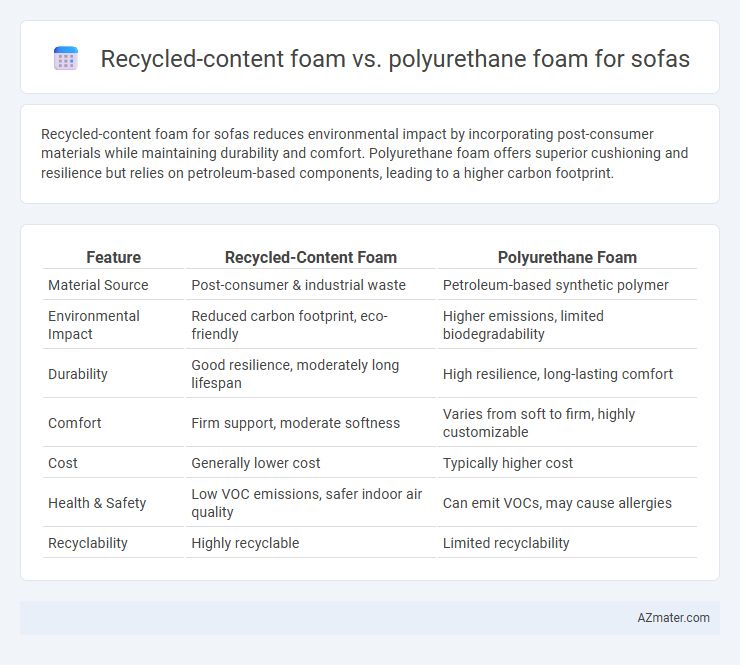Recycled-content foam for sofas reduces environmental impact by incorporating post-consumer materials while maintaining durability and comfort. Polyurethane foam offers superior cushioning and resilience but relies on petroleum-based components, leading to a higher carbon footprint.
Table of Comparison
| Feature | Recycled-Content Foam | Polyurethane Foam |
|---|---|---|
| Material Source | Post-consumer & industrial waste | Petroleum-based synthetic polymer |
| Environmental Impact | Reduced carbon footprint, eco-friendly | Higher emissions, limited biodegradability |
| Durability | Good resilience, moderately long lifespan | High resilience, long-lasting comfort |
| Comfort | Firm support, moderate softness | Varies from soft to firm, highly customizable |
| Cost | Generally lower cost | Typically higher cost |
| Health & Safety | Low VOC emissions, safer indoor air quality | Can emit VOCs, may cause allergies |
| Recyclability | Highly recyclable | Limited recyclability |
Introduction: The Evolution of Sofa Foam Materials
Recycled-content foam offers an eco-friendly alternative to traditional polyurethane foam in sofa manufacturing by incorporating post-consumer and industrial waste materials that reduce environmental impact. Polyurethane foam, known for its durability and comfort, remains a standard in the industry but faces sustainability challenges due to its petroleum-based composition. Innovations in recycled-content foam aim to balance performance and environmental responsibility, reflecting evolving consumer demand for greener home furnishing options.
What Is Recycled-Content Foam?
Recycled-content foam is a type of cushioning material made by incorporating recycled polyurethane foam scraps and other post-industrial waste into new foam products, reducing environmental impact. This foam maintains similar comfort and durability to traditional polyurethane foam while offering a more sustainable option by diverting waste from landfills. Manufacturers optimize recycled-content foam for sofas by balancing recycled and virgin materials to meet performance and quality standards.
Understanding Polyurethane Foam
Polyurethane foam, known for its durability and comfort, serves as a primary cushioning material in sofas, offering excellent support and resilience. Unlike recycled-content foam, polyurethane foam provides consistent density and firmness, which contributes to maintaining shape and comfort over time. Its versatile formulation allows for customization in firmness levels, making it ideal for various sofa designs and user preferences.
Environmental Impact: Recycled-Content Foam vs Polyurethane Foam
Recycled-content foam significantly reduces environmental impact by diverting waste from landfills and lowering the demand for virgin petroleum-based materials used in conventional polyurethane foam production. It typically has a smaller carbon footprint, contributing to decreased greenhouse gas emissions during manufacturing and end-of-life disposal. Polyurethane foam, while durable and widely used, involves energy-intensive processes and releases volatile organic compounds (VOCs), posing greater environmental and health concerns throughout its lifecycle.
Comfort and Support Comparison
Recycled-content foam offers comparable comfort to traditional polyurethane foam by maintaining similar density and resilience, making it a sustainable choice without sacrificing support. Polyurethane foam typically provides consistent firmness and superior support for prolonged seating, ideal for maintaining sofa shape and durability. Both foams balance comfort and support, but recycled-content foam excels environmentally while polyurethane foam remains the standard for structured cushioning.
Durability and Longevity Insights
Recycled-content foam offers enhanced environmental benefits but generally exhibits lower durability and longevity compared to traditional polyurethane foam, which is known for its robust resilience and extended lifespan in sofa cushions. Polyurethane foam maintains its shape and support over years of regular use, resisting sagging and degradation better than many recycled-content alternatives. Choosing high-density polyurethane foam can significantly improve sofa durability, while recycled-content foam's eco-friendly appeal may require more frequent replacement due to reduced structural integrity.
Cost Comparison: Upfront and Long-term
Recycled-content foam generally offers a lower upfront cost compared to traditional polyurethane foam, making it an attractive option for budget-conscious consumers. However, polyurethane foam typically provides greater durability and resilience, resulting in lower long-term replacement and maintenance expenses. Evaluating total cost of ownership reveals that while recycled-content foam reduces initial investment, polyurethane foam's extended lifespan may prove more cost-effective over time.
Allergen and Chemical Safety Considerations
Recycled-content foam for sofas offers lower levels of volatile organic compounds (VOCs) and fewer off-gassing chemicals compared to conventional polyurethane foam, reducing potential allergen exposure and chemical sensitivities. Polyurethane foam often contains flame retardants and isocyanates, which can trigger allergic reactions and respiratory issues in sensitive individuals. Choosing recycled-content foam supports improved indoor air quality and enhances chemical safety by minimizing exposure to harmful substances commonly found in traditional polyurethane foam.
Sustainability and Eco-Friendliness
Recycled-content foam for sofas significantly reduces environmental impact by utilizing post-consumer and post-industrial materials, lowering waste and conserving natural resources compared to traditional polyurethane foam derived from petroleum. This foam type enhances sustainability through decreased carbon footprint and supports circular economy principles in furniture manufacturing. Polyurethane foam, while durable and comfortable, typically involves petrochemical processes with higher emissions and limited recyclability, making recycled-content foam a more eco-friendly choice for environmentally conscious consumers.
Which Foam Is Better for Your Sofa?
Recycled-content foam offers an eco-friendly option for sofas, providing comparable durability and comfort to traditional polyurethane foam while reducing environmental impact through the use of post-consumer plastics. Polyurethane foam remains popular for its high resilience, versatility in density options, and superior cushioning performance, which ensures long-lasting support and comfort. Choosing the better foam depends on whether sustainability is a priority or if maximum durability and customizable firmness levels are more critical for your sofa's function and longevity.

Infographic: Recycled-content foam vs Polyurethane foam for Sofa
 azmater.com
azmater.com